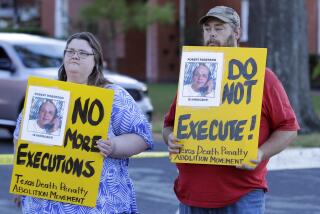Executions on trial
Re “Ruling halts state method of execution,” Dec. 16
California’s lethal injection procedure may have its flaws, but where is it guaranteed that any of us is entitled to a painless death? Why does U.S. District Judge Jeremy Fogel believe that special treatment should be given to a murderer who choked, stabbed, raped and bludgeoned a teenage girl? Certainly this was as painful and horrendous a death as one could imagine without the benefit of a pain-relieving medical cocktail. Michael Morales gave up his right to life when he callously took that right from his victim without regard to her pain and suffering. After more than 20 years of appeals, it is time for him to pay for his crime by being executed.
MICHAEL RUBINO
San Pedro
*
After 40 years of criminal defense practice and having represented defendants in 14 capital prosecutions, I find disingenuous at best the concern with seeking to assure a relatively painless method of execution. As long as we as a society refuse to recognize capital punishment as a relic of our barbaric past, we would be more honest with ourselves if we ignored the means we use to exact revenge for crime.
If we really believe that the death penalty is a laudable goal for a civilized society, we should have no concern about the pain we cause when we kill in the name of justice.
MARK E. OVERLAND
Los Angeles
*
I continue to be amazed at the strange machines people invent to execute prisoners, the attempts to distance the act from error or violence and to make it seemingly painless, from the guillotine and the gallows to the electric chair, gas chamber and needle. I suspect that the old Chinese method is better: a bullet in the back of the brain, destroying it before any nerve impulses can register. Perhaps this is too hands-on for Americans.
PETER D. ZIMMERMAN
London
*
There are many victims involved in every case that ends with an execution. To those who believe in restorative justice, the family of the person who is executed becomes the newest set of victims. There is another set of victims of the death penalty that never comes to mind. These are the people that the state hires to carry out executions.
This was clearly brought home to me when I was part of a delegation to San Quentin in September 2005. Our day ended with a visit to the death chamber. We had a final discussion with the captain who had been our escort for the day, who is also pastor of a Christian church in a nearby community. We asked him how he could preach the love of Jesus on weekends and be part of this killing process during the week. He stunned us with his reply: “You have to leave your faith at the gate to work in this place.” This man is also a victim of the death penalty.
FATHER GEORGE HORAN
Los Angeles
The writer is co-director of the Office of Restorative Justice of the Catholic Archdiocese of L.A.
*
Fogel states that “an execution is not a medical procedure” and, therefore, does not necessarily require the participation of healthcare professionals.
At present, corrections personnel make up the execution team. They alone mix the three-drug cocktail and attach the intravenous catheters.
What Fogel fails to realize is the preparation and application of lethal drugs to an individual requires the skill of trained and dedicated healthcare professionals, not guards. It is the moral obligation of physicians and nurses to finally come forward, put aside their opposition and ensure the humane termination of convicted killers.
DAN ANZEL
Los Angeles
*
Apparently Fogel thinks that lethal injection is a cruel and unusual form of execution. I’d like to remind Fogel that the same people who wrote the prohibition on cruel and unusual punishment into our Bill of Rights also approved of the method of execution called hanging.
MITCHELL HARRIS
La Verne
More to Read
Sign up for Essential California
The most important California stories and recommendations in your inbox every morning.
You may occasionally receive promotional content from the Los Angeles Times.










